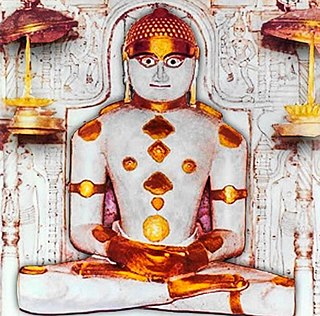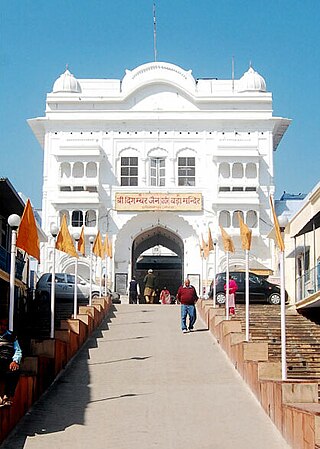Jainism, also known as Jain Dharma, is an Indian religion. Jainism traces its spiritual ideas and history through the succession of twenty-four tirthankaras, with the first in the current time cycle being Rishabhadeva, whom the tradition holds to have lived millions of years ago, the twenty-third tirthankara Parshvanatha, whom historians date to the 9th century BCE, and the twenty-fourth tirthankara Mahavira, around 600 BCE. Jainism is considered an eternal dharma with the tirthankaras guiding every time cycle of the cosmology. The three main pillars of Jainism are ahiṃsā (non-violence), anekāntavāda (non-absolutism), and aparigraha (asceticism).

Mahavira, also known as Vardhamana, was the 24th Tirthankara of Jainism. He was the spiritual successor of the 23rd Tirthankara Parshvanatha. Mahavira was born in the early 6th century BCE to a royal Jain family of ancient India. His mother's name was Trishala and his father's name was Siddhartha. They were lay devotees of Parshvanatha. Mahavira abandoned all worldly possessions at the age of about 30 and left home in pursuit of spiritual awakening, becoming an ascetic. Mahavira practiced intense meditation and severe austerities for twelve and a half years, after which he attained Kevala Jnana (omniscience). He preached for 30 years and attained moksha (liberation) in the 6th century BCE, although the year varies by sect.

The Śvetāmbara is one of the two main branches of Jainism, the other being the Digambara. Śvetāmbara in Sanskrit means "white-clad", and refers to its ascetics' practice of wearing white clothes, which sets it apart from the Digambara or "sky-clad" Jains whose ascetic practitioners go nude. Śvetāmbaras do not believe that ascetics must practice nudity.

Hastinapur is a city in the Meerut district in the Indian state of Uttar Pradesh. Hastinapura, described in Hindu texts such as the Mahabharata and the Puranas as the capital of the Kuru Kingdom, is also mentioned in ancient Jain texts. Hastinapur is located on the right bank of the Ganga river.

Parshvanatha, or Pārśva and Pārasanātha, was the 23rd of 24 Tirthankaras of Jainism. He gained the title of Kalīkālkalpataru.

In Jainism, a tīrtha is used to refer both to pilgrimage sites as well as to the four sections of the sangha. A tirtha provides the inspiration to enable one to cross over from worldly engagement to the side of moksha.

Teej, literally meaning the "third" denoting the third day after the new moon when the monsoon begins as per the Hindu calendar, is a combined name for 3 Hindu festivals primarily dedicated to Hindu deities - the mother goddess Parvati and her male consort Shiva, mainly celebrated by married women and unmarried girls mostly in North India and Nepal to wish for the long life of their husband or future husband and to welcome the arrival of monsoon season with the singing, swings, dancing, enjoyment, prayer rituals and often fasting.

Rishabhanatha, also Rishabhadeva, Rishabha or Ikshvaku, is the first tirthankara of Jainism. He was the first of twenty-four teachers in the present half-cycle of time in Jain cosmology, and called a "ford maker" because his teachings helped one cross the sea of interminable rebirths and deaths. The legends depict him as having lived millions of years ago. He was the spiritual successor of Sampratti Bhagwan, the last Tirthankara of previous time cycle. He is also known as Ādinātha, as well as Adishvara, Yugadideva, Prathamarajeshwara and Nabheya. He is also known as Ikshvaku, establisher of the Ikshvaku dynasty. Along with Mahavira, Parshvanath, Neminath, and Shantinath, Rishabhanatha is one of the five Tirthankaras that attract the most devotional worship among the Jains.

Śāntinātha or Śānti is the sixteenth Tīrthaṅkara of Jainism in the present age. According to traditional accounts, he was born to King Vishvasena and Queen Aćira of the Ikshvaku dynasty in the north Indian city of Hastinapur. His birth date is the thirteenth day of the Jyest Krishna month of the Indian calendar. He was also a Chakravarti and a Kamadeva. He ascended to the throne when he was 25 years old. After over 25,000 years on the throne, he became a Jain monk and started his penance.

Marichi or Mareechi or Marishi is the mind-born son of Brahma, and one of the Saptarishi in Hindu mythology. He is also the father of Kashyapa, and the grandfather of the devas and the asuras.
This article contains the index of articles related to Jainism.
Jainism is a religion founded in ancient India. Jains trace their history through twenty-four tirthankara and revere Rishabhanatha as the first tirthankara. The last two tirthankara, the 23rd tirthankara Parshvanatha and the 24th tirthankara Mahavira are considered historical figures. According to Jain texts, the 22nd tirthankara Neminatha lived about 5,000 years ago and was the cousin of Krishna.

The Ajmer Jain temple, also known as Soniji Ki Nasiyan, is a Jain temple known for its architecture. It was built in the late nineteenth century. The main chamber, known as the Swarna Nagari "City of Gold", has several gold-plated wooden figures, depicting several figures in the Jain religion. This golden chamber of the temple uses 1,000 kg of gold to carve out a depiction of Ayodhya.
Panch Kalyanaka are the five chief auspicious events that occur in the life of tirthankara in Jainism. They are commemorated as part of many Jain rituals and festivals.

Jainism is an Indian religion which is traditionally believed to be propagated by twenty-four spiritual teachers known as tirthankara. Broadly, Jainism is divided into two major schools of thought, Digambara and Śvetāmbara. These are further divided into different sub-sects and traditions. While there are differences in practices, the core philosophy and main principles of each sect is the same.

Auspicious dreams are often described in texts of Jainism which forecast the virtue of children. Their number varies according to different traditions and they described frequently as fourteen or sixteen dreams. They are seen by mothers of the prominent figures in Jainism including Tirthankaras, on the conception of their soul in the womb. They are interpreted as describing virtues and kingship of a future child. They are also found in various artistic media as an ornamentation.

In Jainism, Bharata was the first chakravartin of the Avasarpini. He was the eldest son of Rishabhanatha, the first tirthankara. He had two sons from his chief-empress Subhadra, named Arkakirti and Marichi. He is said to have conquered all six parts of the world and to have engaged in a fight with Bahubali, his brother, to conquer the last remaining city of the world.
Jain festivals occur on designated days of the year. Jain festivals are either related to life events of Tirthankara or they are performed with intention of purification of soul.

Digamber Jain Bada Mandir Hastinapur is a Jain temple complex located in Hastinapur, Uttar Pradesh. It is the oldest Jain temple in Hastinapur dedicated to Shantinatha, the 16th Jain Tirthankara.

Parashurama Jayanti is a Hindu festival observed to celebrate the birth of Parashurama, the sixth incarnation of Vishnu. It is celebrated every year on Akshaya Tritiya, falling on the tritiya tithi of the Shukla Paksha in the Hindu month of Vaisakha.


















